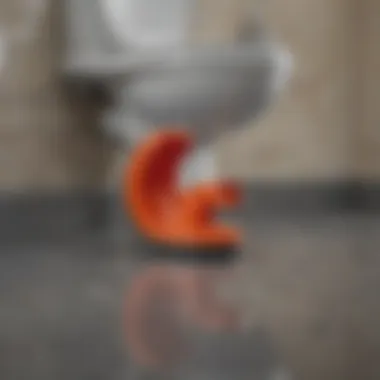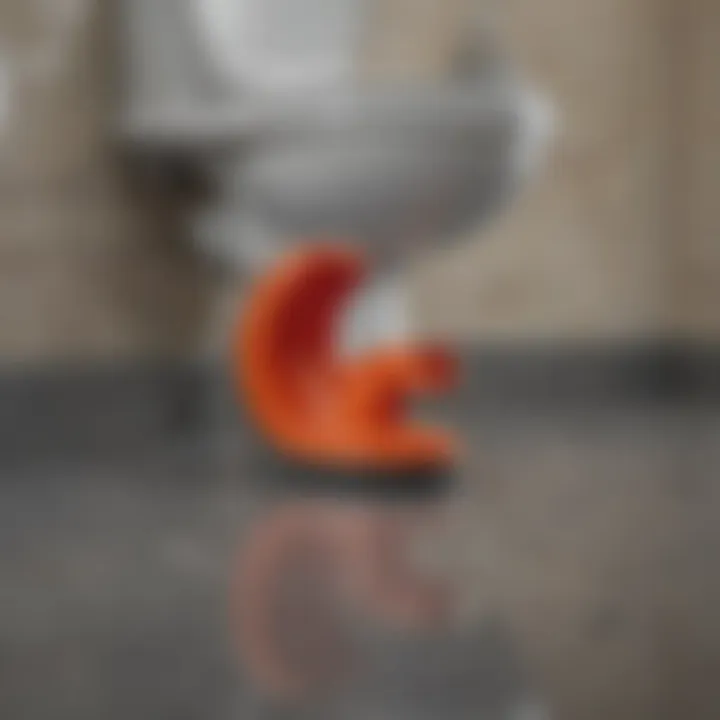Expert Guide on How to Effectively Remove a Clog from a Toilet


To effectively address a clogged toilet, it is crucial to understand various methods and tools available. From plungers to augers, each approach offers a unique solution to tackle the issue. By following a systematic process, you can ensure a smooth and efficient unclogging procedure. The importance of this guide lies in its ability to equip you with the knowledge and skills necessary to handle such plumbing problems effectively..
Preparation
Before beginning the unclogging process, gather essential tools such as a plunger, toilet auger, gloves, and a bucket. These items are indispensable in resolving the blockage efficiently. Additionally, ensuring proper ventilation in the bathroom is crucial for a comfortable and hygienic working environment. Strategic placement of the tools within arm's reach enables quick access during the unclogging process.
Investigation
Upon encountering a clogged toilet, it is imperative to investigate the severity of the blockage. Start by observing the water level in the bowl and assessing if the clog is partial or complete. Understanding the nature of the blockage helps determine the most appropriate method for unclogging. Additionally, inspecting the flushing mechanism and listening for any unusual sounds provides valuable insights into the underlying issue.
Unclogging Techniques
- Plunging: The plunger is a fundamental tool for unclogging toilets. To effectively use a plunger, create a tight seal around the drain opening and push and pull vigorously to dislodge the blockage. Repeat this process several times until the water starts to drain smoothly.
- Auger: A toilet auger, also known as a drain snake, is ideal for tackling stubborn clogs. Insert the auger into the drain and rotate the handle to navigate through the pipe, breaking apart the blockage. Careful maneuvering and persistence are key to successfully unclogging with an auger.
- Natural Remedies: For minor clogs, environmentally friendly solutions such as a mixture of baking soda and vinegar can aid in dislodging the obstruction. Allow the solution to sit in the drain for some time before flushing with hot water.
Post-Unclogging Maintenance
Once the clog is successfully removed, flush the toilet several times to ensure proper drainage. Additionally, conduct a visual inspection to confirm that the water is flowing consistently. Regular maintenance practices like preventing flushing non-flushable items can help minimize the risk of future clogs.
Conclusion
Detaching a clog from a toilet demands a systematic approach and the right set of tools. By following the steps outlined in this guide, you can navigate through the unclogging process effectively, ensuring a smoothly functioning toilet. Remember, patience and methodical execution are key to resolving plumbing issues successfully.
Introduction
In this comprehensive guide titled 'How to Remove a Clog from a Toilet', we delve into the essential steps and techniques required for efficiently unclogging a toilet. Clearing a toilet blockage is a common household maintenance task that can be easily managed with the right approach. Understanding the root causes of toilet clogs and the significance of prompt action is crucial to maintaining a functional plumbing system.
Understanding the Issue
Identifying a Clogged Toilet


Identifying a clogged toilet is often recognizable by the water failing to drain correctly after flushing or rising to the brim of the bowl. This issue signifies a potential blockage within the toilet's drain system, necessitating immediate attention. Recognizing the early signs of a clog allows for swift intervention to prevent further complications and possible damage to the plumbing infrastructure. The ability to accurately pinpoint a toilet blockage sets the foundation for effective unclogging strategies, ensuring a successful resolution of the issue.
Common Causes of Toilet Clogs
Toilet clogs typically stem from the improper disposal of materials such as excessive toilet paper, sanitary products, or foreign objects. The accumulation of these substances in the drain pipes obstructs the normal flow of water, leading to blockages. Furthermore, mineral build-up, tree roots infiltrating the plumbing system, or structural defects can also contribute to frequent toilet clogs. Understanding the common causes of toilet blockages aids in implementing preventive measures and selecting appropriate unclogging methods tailored to specific issues.
Importance of Prompt Action
Implications of Ignoring a Clog
Neglecting a toilet clog can result in increased water damage, foul odors, and potential health hazards due to bacterial growth. Ignoring the initial signs of a blockage exacerbates the problem, leading to more extensive repairs and higher maintenance costs. Promptly addressing a clogged toilet not only mitigates these risks but also ensures the efficient operation of the plumbing system. Taking immediate action upon identifying a clog is imperative to avert unwanted consequences and maintain a hygienic living environment.
Methods for Unclogging
In this article, the section on Methods for Unclogging plays a crucial role in equipping readers with essential skills to address toilet clogs efficiently. By delving into various unclogging techniques, this segment offers a comprehensive insight into tackling this common household issue. Understanding the importance of each unclogging method, their benefits, and specific considerations aids in empowering individuals to resolve toilet clogs promptly and effectively.
Choosing the Right Plunger
When it comes to Choosing the Right Plunger, it is essential to select a plunger that matches the specific type of toilet and clog at hand. The key characteristic of a suitable plunger lies in its ability to create a strong suction seal, allowing for effective plunging action. This feature facilitates the dislodging of blockages with precision and minimal effort, making it a popular choice for resolving toilet clogs. The unique design of a proper plunger ensures a tight seal, which maximizes the suction force, consequently enhancing its unclogging capabilities.
Plunging Technique
The Plunging Technique is a fundamental aspect of unclogging toilets efficiently. Mastering the correct plunging technique is vital for achieving successful results. The key characteristic of this technique lies in its combination of forceful plunging motions with proper positioning of the plunger. By applying consistent pressure and maintaining a tight seal, the plunging action dislodges stubborn clogs effectively. This technique is popular for its simplicity and effectiveness in clearing toilet blockages. However, it is important to note that improper plunging technique may result in ineffective unclogging, emphasizing the significance of utilizing this method correctly.
Using a Plumbing Snake
The section on Using a Plumbing Snake explores an alternative method for addressing challenging toilet clogs. Inserting and Maneuvering the Snake involves skillful navigation of the tool through the toilet drain to reach the blockage. The key characteristic of this approach is its ability to access deep-seated clogs that may be resistant to plunging. The unique feature of a plumbing snake lies in its flexibility and reach, allowing for targeted blockage removal without causing damage to the toilet system.
Retrieving the Blockage


Retrieving the Blockage using a plumbing snake requires precision and patience. The key characteristic of this process is the controlled movement of the snake to grasp and extract the blockage from the drain. By carefully maneuvering the tool, users can effectively dislodge and retrieve the obstruction, restoring the proper flow within the toilet system. The advantage of this method is its ability to tackle complex clogs that cannot be resolved through traditional plunging techniques.
Homemade Solutions
Exploring Homemade Solutions offers a natural and DIY approach to resolving toilet clogs. Baking Soda and Vinegar present a potent yet gentle solution for breaking down organic materials causing clogs. The key characteristic of this mixture is its foaming action, which helps dislodge and dissolve blockages effectively. It is a popular choice for environmentally conscious individuals seeking non-toxic unclogging methods. However, the effervescence of the mixture may lack the force needed for severe clogs, requiring alternative solutions for stubborn blockages.
Hot Water and Dish Soap
Utilizing Hot Water and Dish Soap provides a simple yet effective homemade solution for minor toilet clogs. The key characteristic of this mixture is the combination of hot water's flushing power with the grease-cutting properties of dish soap. This approach is a popular choice for initially addressing soft clogs or minor blockages. While its easy accessibility and household ingredients make it a convenient solution, its effectiveness may vary based on the nature and severity of the clog.
Tools for the Job
When it comes to addressing a clogged toilet, having the right tools is essential for a successful unclogging process. The section on 'Tools for the Job' in this comprehensive guide delves into the crucial equipment necessary to effectively tackle toilet clogs. From plungers to plumbing snakes, each tool plays a vital role in clearing the blockage and restoring proper toilet function. Properly equipping yourself with the essential tools ensures that you can confidently handle any clogging issue that arises.
Essential Equipment
Plunger
Discussing the pivotal role of the plunger in unclogging a toilet is paramount. The plunger, a staple tool in every household, serves as a versatile and efficient solution for eliminating blockages. Its design, featuring a rubber suction cup, allows for effective pressure application to dislodge and push the obstruction through the pipes. The significance of the plunger lies in its simplicity yet exceptional effectiveness in resolving toilet clogs promptly. A key benefit of using a plunger is its accessibility and ease of use, making it a go-to choice for many individuals facing toilet issues. Despite its straightforward operation, the plunger's unique ability to create a seal over the drain ensures maximal force application for optimal results. However, a potential disadvantage of using a plunger is the necessity for manual effort and physical exertion, which may not always guarantee success depending on the severity of the clog.
Plumbing Snake
Exploring the functionality of a plumbing snake is crucial for understanding its contribution to the unclogging process. The plumbing snake, a specialized tool designed for navigating through pipes, offers a targeted approach to dislodging and removing stubborn obstructions. Its key characteristic lies in its flexibility and elongated structure, which allows it to reach deep into the pipes to break apart blockages. The plumbing snake's popularity stems from its ability to maneuver through twists and turns in the plumbing system, effectively clearing debris obstructing the flow. One unique feature of the plumbing snake is its coiled design, which assists in grabbing onto clogs and extracting them with precision. The advantage of using a plumbing snake is its capability to reach blockages that may be inaccessible to a plunger, providing a comprehensive solution for intricate toilet clogs. However, a potential disadvantage of the plumbing snake is the need for careful handling to prevent damage to the toilet's internal components during use.
Gloves
Considering the role of gloves in the unclogging process highlights their importance in maintaining cleanliness and hygiene. Gloves serve as a protective barrier between the individual and potentially hazardous substances present in a clogged toilet. Their key characteristic of being waterproof and durable ensures that the user can handle the task without direct contact with unsanitary conditions. The popularity of gloves in this context arises from their practicality in preventing skin exposure to bacteria or waste matter, promoting a safe and hygienic unclogging experience. One unique feature of gloves is their disposable nature, allowing for easy disposal after use to maintain sanitation standards. The advantages of using gloves include protecting the user's hands from contamination and facilitating a sanitary environment while dealing with a clogged toilet. However, a potential disadvantage of gloves is the need for proper disposal to prevent further contamination or spread of germs post unclogging.
Preventive Measures


In the realm of toilet maintenance, Preventive Measures play a crucial role in ensuring the smooth functioning of this essential fixture in our homes. By implementing proactive strategies to avoid clogs, individuals can save time, money, and unnecessary stress associated with a blocked toilet. Regular preventive actions not only prevent immediate inconveniences but also extend the longevity of the plumbing system. It is prudent to incorporate Preventive Measures as part of a routine household maintenance plan to promote a hassle-free toilet experiencen## Maintaining a Clear Drain
Regular Cleaning Practices
Regular Cleaning Practices serve as the cornerstone of maintaining a clear drain in a toilet. Consistent cleaning not only removes residue and buildup but also helps in identifying potential issues before they escalate into major clogs. The key characteristic of Regular Cleaning Practices is their ability to prevent blockages by keeping the drain free from any obstructions. This method stands out as a beneficial choice for this article due to its practicality and effectiveness in promoting proper toilet hygiene. A unique feature of Regular Cleaning Practices lies in their simplicity and cost-efficiency, offering an easy yet impactful solution to prevent clogs and maintain optimal toilet functionality, especially in households prone to plumbing issues.
Disposal of Disposables
Disposal of Disposables is a pivotal aspect of ensuring a clear drain and preventing toilet clogs. Proper disposal of items such as wet wipes, facial tissues, or sanitary products is essential to avoid blockages caused by non-dissolvable materials. The key characteristic of Disposal of Disposables lies in promoting responsible waste management to safeguard the plumbing system's integrity from potential obstructions. This method is a prudent choice for this article as it emphasizes the importance of mindful waste disposal to maintain a healthy and efficient toilet drainage system. A unique feature of Disposal of Disposables is its direct impact on preventing avoidable clogs and subsequent plumbing issues, making it a proactive approach to preserving the functionality of the toilet.
Professional Assistance
In the realm of toilet clog removal, understanding when to seek professional assistance is crucial for seamlessly resolving persistent issues beyond basic DIY methods. While plungers and snakes prove effective in many cases, certain situations demand the expertise of a plumber. Opting for professional help not only ensures a thorough examination of the problem but also guarantees a long-term solution to complex clogs. Plunging and snaking can address common clogs, but for recurring blockages or underlying plumbing system malfunctions, a plumber's intervention becomes indispensable.
Within the domain of professional assistance, the role of a plumber extends beyond just unclogging toilets. Plumbers possess the knowledge and tools to address intricate plumbing issues that may not be apparent to untrained individuals. Their adeptness in diagnosing underlying problems with the plumbing system helps prevent future clogs and ensures the seamless functioning of the toilet. By calling a plumber at the right time, homeowners can avert potential structural damage or more extensive plumbing issues.
Expertise and experience are the cornerstones of professional plumbing services. Plumbers can quickly pinpoint the exact cause of persistent clogs and implement targeted solutions to rectify the issue permanently. Their proficiency in dealing with a wide array of plumbing problems equips them to tackle even the most challenging clogs effectively. Valuing the importance of timely and expert professional assistance can save homeowners from unnecessary stress and expenses in the long run. When faced with relentless clogs or indications of broader plumbing concerns, enlisting the expertise of a plumber is a proactive step towards maintaining a well-functioning toilet.
When to Call a Plumber
Persistent Clogs
For stubborn and recurring toilet clogs that resist conventional unclogging methods, knowing when to call a plumber is paramount. Persistent clogs signify underlying issues that regular plunging or snaking cannot resolve. These clogs typically reoccur shortly after being cleared, indicating a more profound obstruction in the plumbing system. Calling a plumber in such instances is essential to identify and address the root cause of the persistent clogs, preventing further inconvenience and damage.
Persistent clogs often result from obstructions deep within the pipes, such as accumulated debris or tree root ingress. These blockages require specialized tools and expertise to eliminate completely. Plumbers utilize techniques like hydro-jetting to clear out stubborn clogs efficiently. Moreover, continuous clogging can indicate problems with the toilet's flushing mechanism or the main sewage line. By engaging a plumber for persistent clogs, homeowners can receive a comprehensive inspection of the plumbing system, ensuring that all contributing factors are addressed.
The advantage of seeking professional assistance for persistent clogs lies in the thorough analysis and lasting solutions provided by trained plumbers. While temporary fixes can alleviate immediate blockages, a plumber's intervention guarantees a definitive resolution to recurring clogging issues. Additionally, plumbers can offer valuable insights on preventive measures to maintain a clear and obstruction-free toilet system. Addressing persistent clogs promptly through professional help safeguards the structural integrity of the plumbing system and promotes consistent functionality.
Issues with Plumbing System
When encountering persistent toilet clogs, it is imperative to assess for potential issues within the plumbing system that may be exacerbating the problem. Issues with the plumbing system can manifest in various ways, impacting the toilet's drainage efficiency and overall performance. Identifying and rectifying these underlying plumbing issues is essential to ensure a functional and clog-free toilet system.
A common issue within the plumbing system that can lead to recurring clogs is inadequate pipe slope or improper venting. These factors hinder the smooth flow of waste and water, contributing to blockages over time. Moreover, sediment buildup and mineral deposits in the pipes can impede proper drainage, necessitating professional intervention for thorough cleaning and restoration. By addressing these plumbing system concerns proactively, homeowners can prevent recurrent clogs and maintain optimal toilet functionality.
Understanding the nuances of the plumbing system is crucial when dealing with toilet clogs. Plumbers possess the expertise to conduct comprehensive assessments and identify potential issues such as pipe corrosion, leaks, or compromised seals. By diagnosing and resolving these plumbing system issues promptly, plumbers ensure the longevity and efficiency of the toilet system. Collaboration with skilled plumbing professionals can alleviate the stress of persistent clogs and promote a smoothly operating plumbing system, enhancing overall household functionality and comfort.



